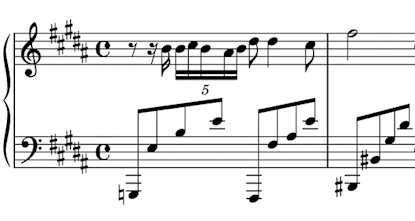Irregular Tuplets
We have already learned that triplets are “three notes in the time of two”, and that duplets are “two notes in the time of three”. In fact, we can fit any number of notes into any size of beat, just by adding a number which shows how many notes there are – this group is called a tuplet.
To work out how many and what type of note the tuplet replaces, first work out how many “normal” notes would fit in the required spot.
In this first example (Chopin, Nocturne in Eb, op.55 no.2) the quintuplet is written in quavers (8th notes) where we would normally expect three (see the left hand). This tuplet requires “five notes in the time of three”.

In this example (Nocturne in Bb minor op.9 no.1) Chopin has stretched 22 quavers (8th notes) across the whole bar, so this tuplet requires “22 notes in the time of 12”.

And finally, here Chopin (Nocturne in B major, op.32 no.1) writes semiquavers (16th notes), which asks for “five notes in the time of four”.
